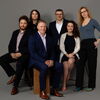Processing Your Payment
Please do not leave this page until complete. This can take a few moments.
- News
-
Editions
View Digital Editions
Biweekly Issues
- May 13, 2024
- April 29, 2024
- April 15, 2024
- April 1, 2024
- March 18, 2024
- March 4, 2024
- February 19, 2024
- February 5, 2024
- January 22, 2024
- + More
Special Editions
- Lists
- Viewpoints
- HBJ Events
- Business Calendar
- Custom Content
Fish story: Aquaculture enterprise grows in Waterbury
 Photograph | Nicole Zappone
Ideal Fish CEO Eric Pedersen.
Photograph | Nicole Zappone
Ideal Fish CEO Eric Pedersen.
 PHOTOGRAPH | NICOLE ZAPPONE
The branzini in their (temporary) habitat.
PHOTOGRAPH | NICOLE ZAPPONE
The branzini in their (temporary) habitat.
Eric Pedersen, who once worked as an investment banker on Wall Street, has now taken the plunge into a very different type of business: the seafood industry.
Today, he calls the former button factory at 64 Avenue of Industry in Waterbury his business home with an enterprise that was born as Great American Aquaculture — but now better known as the Ideal Fish Co.
The company got its start when Pedersen left his job as CEO of a developmental-stage company in the water-filtration industry to focus full time on aquaculture. To his young children’s delight (but his wife’s dismay, at least in the beginning), he constructed a small recirculating aquaculture system in the basement of their Stamford home and stocked it with Mediterranean sea bass fingerlings (dicentrarchus labrax, better known by their Italian name, branzino) purchased from a hatchery in New Hampshire. Before he knew it, he had more than 500 baby branzino growing in his basement.
“Eventually, my wife became sufficiently amused by my preoccupation with aquaculture and the basement system that she would show it off to dinner guests at our home,” Pedersen said.
Pederson and his branzini have long since moved on from the company’s basement birthplace. Ideal Fish opened for business in 2013 in Stamford. Three years later the aquaculture entrepreneur relocated the fast-growing enterprise to a 63,000-square-foot factory in Waterbury that previously housed the Waterbury Button Co. So confident of success was Pedersen, he signed a 40-year lease for the space with the owner/landlord, who acquired the property in 2011.
“Waterbury proved to be a very attractive location, because it is centrally located in Connecticut, halfway between Boston and New York City,” explained Pedersen.
He also characterizes Waterbury as a beautiful city run by a very supportive and business-friendly administration under Mayor Neil O’Leary. Reflecting its metal-fabrication legacy, the Brass City offers more-than-adequate industrial infrastructure (water, power, wastewater treatment, gas, transportation infrastructure) necessary to support a high-technology production business like Ideal Fish, Pedersen added.
High-tech cultivation
The facility raises Mediterranean sea bass in a recirculating aquaculture system (RAS), a land-based, self-contained system that cleans, optimizes and recirculates the water in which the fish grow to maturity. Ideal Fish is the first enterprise to raise branzino in a salt-water recirculating system in Connecticut.
Cultivating the fish is a time-consuming process that requires patience and painstaking attention to detail. It takes just a little over a year to raise the sea bass to maturity. Once the fish are acquired, a tiny tag is attached to their gills that has a code that can be tracked through the Ideal Fish website. On the site, the code tells the viewer all about the individual fish: its age, where it originated, how long it has been at the Waterbury facility, etc.
At four months, the fish are moved to one of the 12 larger tanks in a what’s called a “grow-out” system, where they live, eat and grow for another eight to 10 months. Harvest size is about a pound. The fish are then packaged in 100-percent recyclable boxes before being delivered to customers, which usually takes place within 24 hours of harvest.
Ideal Fish’s inaugural harvest is scheduled for September. That’s when the company will begin selling to local grocery stores and restaurants. Eventually, fish will be sold directly to the public as well at a retail window at the Waterbury facility.
Branzino commonly sells at retail outlets for between $8 and $12 per pound, according to Pedersen.
Pedersen decided to raise and sell Mediterranean sea bass, exclusively, because he considers it to be a delicious, flaky and mild-tasting fish that is particularly appealing to the American palate. He adds that consumers in the United States generally prefer fish that have a mild flavor over those with a strong or fishy taste. The company touts its product as “the world’s purest fish.”
Branzino have surged in popularity over just the last five years. U.S. consumption of the sea bass is growing at an annual rate of 15 percent — a trend Pedersen expects to continue for the foreseeable future.
Domestic cultivation
Pedersen sees an opportunity in domestic cultivation of the sea bass in the U.S. Here, imports account for more than 90 percent of all seafood sold in stores and served in restaurants. Importation of food products carries the risk of uncertain origins and handling.
Moreover, Pedersen said that about half of all seafood imported into the U.S. originates in developing nations, many of which do not have the regulatory infrastructure to ensure that the seafood produced is both safe to eat and cultivated in an environmentally sustainable way.
“All the branzino we eat in this country is farm-raised in sea cage farms in the Mediterranean region,” Pedersen said. “By the time it reaches the ice case at the retailer, the fish has traveled many miles, been packaged and repackaged and is many days old. We can offer a fish that is unequaled in freshness, has a longer shelf life and is grown right here in the U.S.,” he added.
Pedersen is confident of a strong demand for aquaculture products grown and raised by a company that can harvest and deliver fresh fish within 24 hours, 52 weeks a year, regardless of the season or weather conditions.
Pedersen’s business background is in finance and managing development-stage and entrepreneurial companies. His résumé includes positions at companies including Urban Organics Pentair Group, the Water Co., LLC, the Water Fund and GE Water & Process Technologies.
“I believe that the state of Connecticut can uniquely support the development of a significant RAS aquaculture industry, because it is centrally located in the largest seafood market in North America,” said Pedersen, referring to the Boston-to-Washington, D.C. corridor.
Pedersen also plans to expand his business significantly within the state. His leadership team includes facilities manager Matthew Dawson; James MacKnight, the company’s sales and marketing director; senior aquaculture technician Matthew Leegwater; and aquaculture technician Jessica McGuire.
Ideal Fish has worked hard to secure commitments from environmentally conscious, forward-thinking retail and food-service companies.
“Ideal Fish sought to position itself to meet the growing demands from local restaurants and grocery stores for a hyperlocal fresh fish and produce with a low-carbon footprint, free from antibiotics and hormones,” explains Pedersen. “In other words: a pure, ideal fish.”
The company’s branzino product will be available year-round and packaged in 10-kilogram cases. The sea bass has a light, delicate flavor but with a meaty texture. Pedersen says the fish is equally suitable for grilling, broiling and sashimi. Dietary benefits include a high concentration of Omega 3, selenium and vitamins B-12 and D.
Pedersen is justifiably proud of the company he has built. “The facility today reflects my early views of how it might be possible to reinvigorate our current food system by locating land-based aquaculture facilities directly into the markets they serve,” he said.

2022 Giving Guide
This special edition informs and connects businesses with nonprofit organizations that are aligned with what they care about. Each nonprofit profile provides a crisp snapshot of the organization’s mission, goals, area of service, giving and volunteer opportunities and board leadership.
Learn more
Subscribe
Hartford Business Journal provides the top coverage of news, trends, data, politics and personalities of the area’s business community. Get the news and information you need from the award-winning writers at HBJ. Don’t miss out - subscribe today.
Subscribe
2024 Book of Lists
Delivering Vital Marketplace Content and Context to Senior Decision Makers Throughout Greater Hartford and the State ... All Year Long!
Read Here-
2022 Giving Guide
This special edition informs and connects businesses with nonprofit organizations that are aligned with what they care about. Each nonprofit profile provides a crisp snapshot of the organization’s mission, goals, area of service, giving and volunteer opportunities and board leadership.
-
Subscribe
Hartford Business Journal provides the top coverage of news, trends, data, politics and personalities of the area’s business community. Get the news and information you need from the award-winning writers at HBJ. Don’t miss out - subscribe today.
-
2024 Book of Lists
Delivering Vital Marketplace Content and Context to Senior Decision Makers Throughout Greater Hartford and the State ... All Year Long!
ABOUT
ADVERTISE
NEW ENGLAND BUSINESS MEDIA SITES
No articles left
Get access now
In order to use this feature, we need some information from you. You can also login or register for a free account.
By clicking submit you are agreeing to our cookie usage and Privacy Policy
Already have an account? Login
Already have an account? Login
Want to create an account? Register
Get access now
In order to use this feature, we need some information from you. You can also login or register for a free account.
By clicking submit you are agreeing to our cookie usage and Privacy Policy
Already have an account? Login
Already have an account? Login
Want to create an account? Register





0 Comments